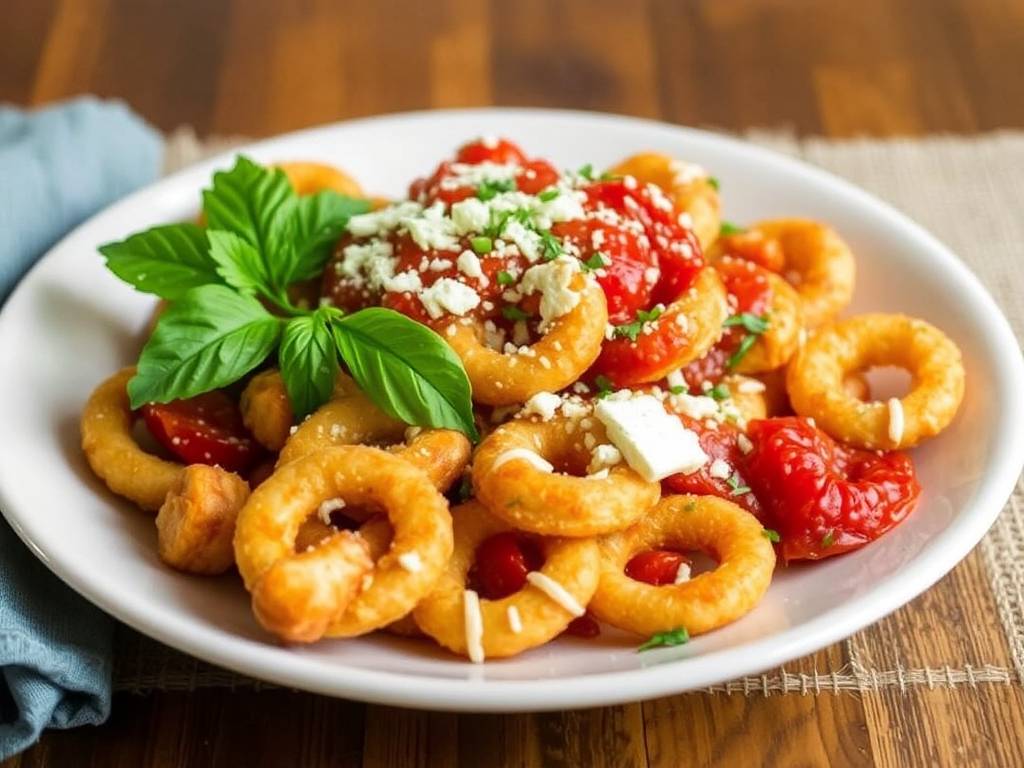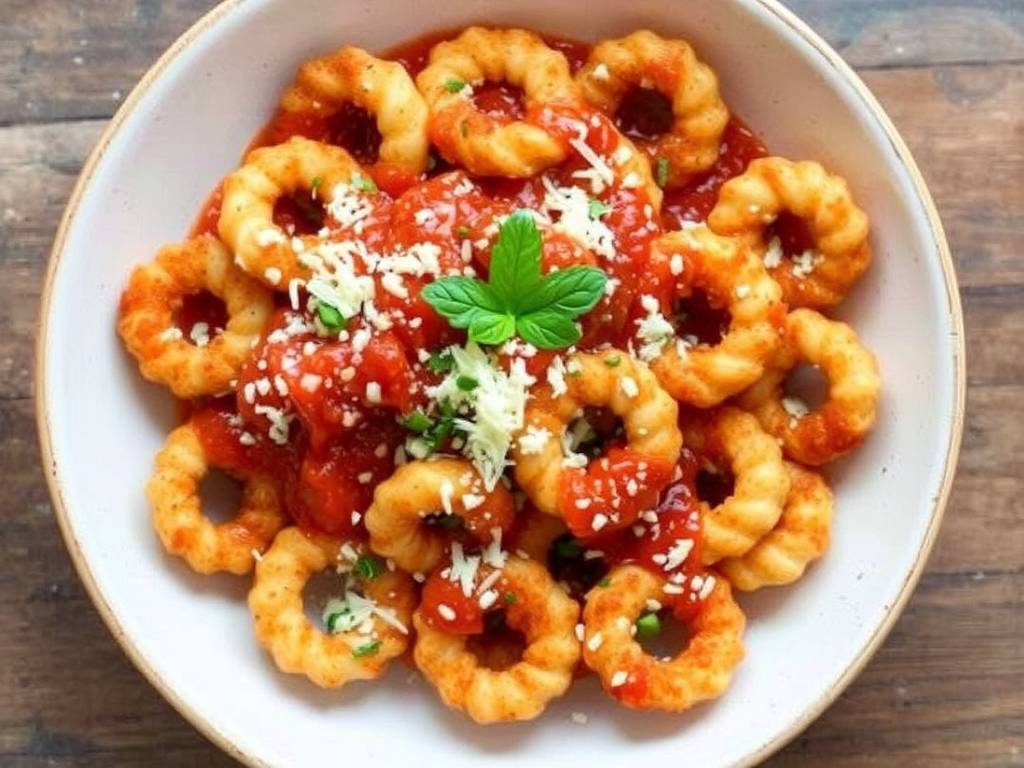Crispy Delights: A Culinary Journey to Perfect Fried Calamari with Marinara and Cheese
The symphony of textures and flavours in a well-executed plate of fried calamari is a culinary experience that transcends borders. The initial, audible crunch gives way to a tender, sweet interior, a contrast that is both thrilling and deeply satisfying. While often enjoyed simply with a squeeze of lemon, elevating this classic dish with a rich, herbaceous marinara sauce and a generous dusting of sharp, salty cheese creates a masterpiece of Italian-American fusion. This is not merely a recipe; it is a journey into technique, ingredient selection, and the art of balancing simplicity with decadence. Achieving perfection requires understanding each component, from sourcing the squid to mastering the fry.
The Foundation: Selecting and Preparing the Squid

The star of our dish is, unequivocally, the squid, or calamari. The first critical decision lies in the choice between fresh or frozen. While fresh squid, with its pearlescent sheen and clean scent of the sea, is ideal, high-quality frozen squid is an excellent and often more convenient alternative. The freezing process does little to damage the delicate texture, making it a reliable choice for most home cooks.
The preparation stage is where tenderness is won or lost. Squid comprises two main edible parts: the tubular body (the tube) and the tentacles. To clean a whole squid, gently pull the head and tentacles away from the body. The internal quill (a clear, plastic-like piece) will usually come out with them. Remove and discard the innards. Under running water, peel off the thin, speckled membrane from the tube; this ensures a more appealing final colour and texture. Finally, rinse the tentacles, removing the beak from the center of the ring where the tentacles meet. Pat everything completely dry with paper towels. Moisture is the enemy of a crisp coating.
The cut is the next crucial step. For the tubes, slice them into uniform rings, about ¾-inch thick. This consistent size is paramount for even cooking. A ring that is too thick will be rubbery inside by the time the coating is golden; one that is too thin risks overcooking into a tough, chewy morsel. The tentacles can be left whole or halved if particularly large. Some aficionados argue that the tentacles, with their higher surface area, offer the ultimate crispy bite.
The Armor: Crafting the Perfect Coating
The coating on fried calamari serves a dual purpose: it provides the iconic crispy texture and protects the delicate squid from the intense heat of the oil. The debate often centres on flour versus batter. For the classic, light, and crackly crust that defines great calamari, a simple dredge in seasoned flour is superior to a thick, tempura-like batter.
The base of our coating is all-purpose flour. To this, we build layers of flavour. A generous amount of kosher salt and freshly ground black pepper is essential. From here, the seasoning palette can expand. Sweet paprika adds a subtle warmth and a beautiful colour, while a pinch of cayenne pepper introduces a gentle, lingering heat. Garlic powder and onion powder contribute a savoury depth that permeates the crust.
For an extra dimension of crispiness, many chefs incorporate a starchy component. A combination of 75% all-purpose flour and 25% cornstarch is a professional secret. The cornstarch inhibits gluten development, resulting in a lighter, less doughy crust that stays crisper for longer. Some recipes even use rice flour for an exceptionally delicate and airy texture.
The dredging process must be efficient. Place the seasoned flour mixture in a large bowl or a sturdy paper bag. Add the dried calamari pieces and toss or shake vigorously until each piece is lightly but thoroughly coated. Before frying, it is imperative to shake off the excess flour. A thick, caked-on layer of flour will result in a pasty, greasy coating. The goal is a fine, even dusting. For an extra-crispy result, a double-dredge can be employed: dip the floured calamari in a simple mixture of buttermilk or egg wash, then toss it in the flour once more before frying.
The Crucible: The Art and Science of Frying
Frying is a high-heat technique that demands respect and attention. The choice of oil is important; you need an oil with a high smoke point. Neutral oils like peanut, canola, or vegetable oil are perfect. Olive oil, especially extra virgin, has too low a smoke point and a strong flavour that will overpower the delicate squid.
The quantity of oil is also critical. For true deep-frying, you need enough oil to fully submerge the calamari, allowing it to cook evenly and float freely. A Dutch oven or a heavy-bottomed, deep pot is ideal for maintaining a stable temperature. If you don't have a deep-fryer, a deep, wide skillet with at least two inches of oil will work for pan-frying, though you will need to turn the pieces.
Temperature control is non-negotiable. Use a deep-fry or candy thermometer. The ideal frying temperature for calamari is between 375°F and 385°F (190°C - 196°C). If the oil is too cool, the calamari will absorb excess oil, becoming greasy and soggy. If the oil is too hot, the coating will burn before the squid has time to cook through, resulting in a bitter exterior and a raw interior.
Work in small, manageable batches. Overcrowding the pot is a cardinal sin. Adding too much cold calamari at once will cause the oil temperature to plummet dramatically. Gently lower the floured calamari into the hot oil using a spider strainer or slotted spoon. They will sizzle immediately. Fry for only 1.5 to 2 minutes, until they are a pale golden brown. Do not be tempted to cook them longer; squid becomes tough and rubbery when overcooked. It cooks incredibly fast. As soon as they are golden, remove them and drain on a wire rack set over a baking sheet, preferably lined with paper towels. Season immediately with a pinch of salt while they are still hot and porous. This final seasoning adheres perfectly.
The Accompaniments: Marinara and Cheese

While the calamari is sublime on its own, the additions of marinara and cheese transform it into a hearty, shareable appetizer or even a main course.
A robust, flavourful marinara sauce is key. While a high-quality store-bought sauce can be a timesaver, a simple homemade version elevates the dish immensely. Start with a base of sautéed garlic and a pinch of red pepper flakes in olive oil. Before the garlic browns, add a can of high-quality crushed San Marzano tomatoes. Their sweet, low-acidity flavour is unparalleled. Simmer gently for 20-30 minutes, allowing the flavours to meld. Stir in fresh torn basil leaves and a pinch of salt at the end. The sauce should be served warm, either as a dipping pool on the plate beneath the calamari or on the side.
The cheese provides a salty, umami-rich finish that cuts through the richness of the fried food. The classic choice is Pecorino Romano. Made from sheep's milk, it has a sharper, saltier, and more complex flavour than its cousin, Parmigiano-Reggiano. Using a microplane, grate the cheese finely so it melts slightly upon contact with the hot calamari. A shower of this cheese just before serving adds a final layer of savoury perfection.
Plating and Presentation
The assembly of the dish is the final act. Spread a ladle of the warm marinara sauce onto the centre of a warmed plate. Artfully pile the golden, crispy calamari over the sauce. Alternatively, serve the sauce in a small ramekin to preserve the crunch of the calamari for as long as possible. Generously grate the Pecorino Romano over the top. A final garnish of freshly chopped Italian parsley adds a touch of colour and freshness. Serve immediately, with lemon wedges on the side for those who desire a bright, acidic spark.
The first bite should be a revelation: the shatter of the crust, the tender give of the squid, the tangy sweetness of the marinara, and the sharp saltiness of the cheese all converging in a harmonious burst. This is more than a recipe; it is an invitation to master a technique and create a dish that is both comforting and spectacular. From the careful preparation of the squid to the precise control of the fryer, every step is a testament to the idea that the simplest dishes, when executed with care and knowledge, can be the most extraordinary.






发表评论